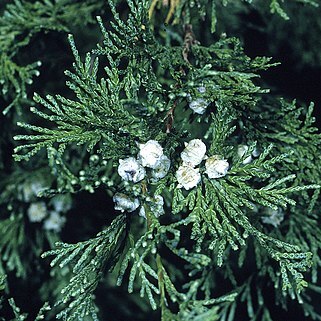Trees to 20(-28) m tall; trunk to 0.8(-1.5) m d.b.h.; bark dark reddish brown, irregularly furrowed and ridged; leafy branchlets fan-shaped. Leaves to 2 mm, usually with circular abaxial gland, apex acute to acuminate; leaves on lower side of branchlets not or only slightly glaucous. Pollen cones dark brown, 2-4 mm; pollen sacs yellow. Seed cones bluish purple to reddish brown, glaucous, globose, 4-9 mm in diam.; cone scales 5-7, fertile scales each with 1 or 2 seeds. Seeds 2-3 mm; wing narrower than seed.
Slender tree to 25 m; ultimate branchlets ca 1 mm wide; lvs imbricate, ovate, 2–4 mm, pointed, usually glandular, persisting and enlarging on the older branches; cones 6–8 mm, the scales ca 6, pointed in the center. Swamps and bogs, chiefly on the coastal plain; s. Me. and c. N.H. to Fla. and Miss.


